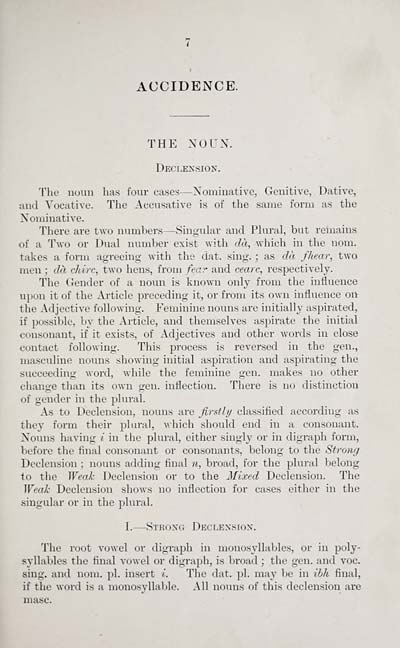Download files
Complete book:
Individual page:
Thumbnail gallery: Grid view | List view

ACCIDENCE.
THE NOUN.
Declension.
The noun has foui* cases — Nominative, Genitive, Dative,
-and Vocative. The Accusative is of the same form as the
Xominative.
There ai-e two numbers — Singular and Phiral, but remains
of a Two or Dual number exist with da, which in the nom.
takes a form agreeing with the dat. sing. ; as da fhear, two
men ; da chirc, two hens, from feay and cearc, respectively.
The Gender of a noun is known only from the influence
upon it of the Article preceding it, or from its own influence on
tlie Adjective following. Feminine nouns are initially aspirated,
if possible, by the Article, and themselves aspirate the initial
consonant, if it exists, of Adjectives and other words in close
contact following. This process is reversed in the gen.,
masculine nouns showing initial aspiration and aspirating the
succeeding word, while the feminine gen. makes no other
ciiange than its own gen. inflection. There is no distinction
of gender in the plural.
As to Declension, nouns are firstly classified according as
they form their plural, which should end in a consonant.
Xouns having i in the plural, either singly or in digraph form,
before the final consonant or con.sonants, belong to the Strong
Declension ; nouns adding final n, broad, for the plural belong
to the Weak Declension or to the Mixed Declension. The
Weak Declension shows no inflection for cases either in the
singular or in the plural.
1. — Strong Declension.
The root vowel or digraph in monosyllables, or in poly-
syllables the final vowel or digraph, is bi-oad ; the gen. and voc.
sing, and nom. pi. insert i. The dat. pi. may be in ibh final,
if the word is a monosyllable. All nouns of this declension are
masc.
THE NOUN.
Declension.
The noun has foui* cases — Nominative, Genitive, Dative,
-and Vocative. The Accusative is of the same form as the
Xominative.
There ai-e two numbers — Singular and Phiral, but remains
of a Two or Dual number exist with da, which in the nom.
takes a form agreeing with the dat. sing. ; as da fhear, two
men ; da chirc, two hens, from feay and cearc, respectively.
The Gender of a noun is known only from the influence
upon it of the Article preceding it, or from its own influence on
tlie Adjective following. Feminine nouns are initially aspirated,
if possible, by the Article, and themselves aspirate the initial
consonant, if it exists, of Adjectives and other words in close
contact following. This process is reversed in the gen.,
masculine nouns showing initial aspiration and aspirating the
succeeding word, while the feminine gen. makes no other
ciiange than its own gen. inflection. There is no distinction
of gender in the plural.
As to Declension, nouns are firstly classified according as
they form their plural, which should end in a consonant.
Xouns having i in the plural, either singly or in digraph form,
before the final consonant or con.sonants, belong to the Strong
Declension ; nouns adding final n, broad, for the plural belong
to the Weak Declension or to the Mixed Declension. The
Weak Declension shows no inflection for cases either in the
singular or in the plural.
1. — Strong Declension.
The root vowel or digraph in monosyllables, or in poly-
syllables the final vowel or digraph, is bi-oad ; the gen. and voc.
sing, and nom. pi. insert i. The dat. pi. may be in ibh final,
if the word is a monosyllable. All nouns of this declension are
masc.
Set display mode to: Large image | Transcription
Images and transcriptions on this page, including medium image downloads, may be used under the Creative Commons Attribution 4.0 International Licence unless otherwise stated. ![]()
| Early Gaelic Book Collections > Hew Morrison Collection > How to learn Gaelic > (19) |
|---|
| Permanent URL | https://digital.nls.uk/79790367 |
|---|
| Description | A selection of items from a collection of 320 volumes and 30 pamphlets of literary and religious works in Scottish Gaelic. From the personal library of Hew Morrison, the first City Librarian of Edinburgh. |
|---|
| Description | Selected items from five 'Special and Named Printed Collections'. Includes books in Gaelic and other Celtic languages, works about the Gaels, their languages, literature, culture and history. |
|---|

